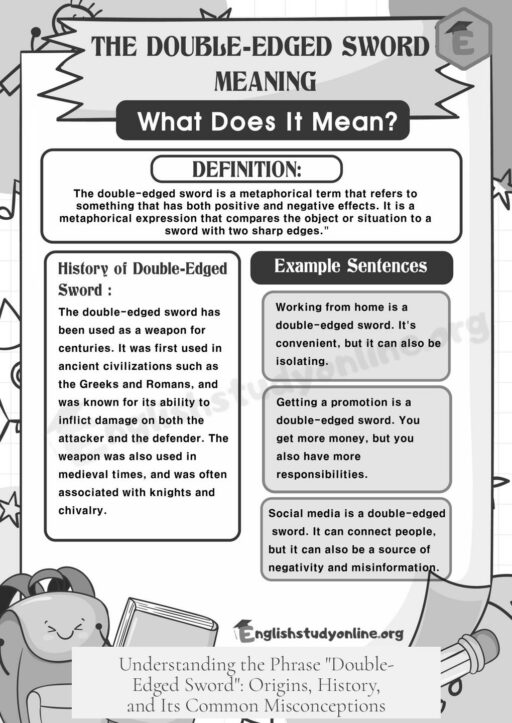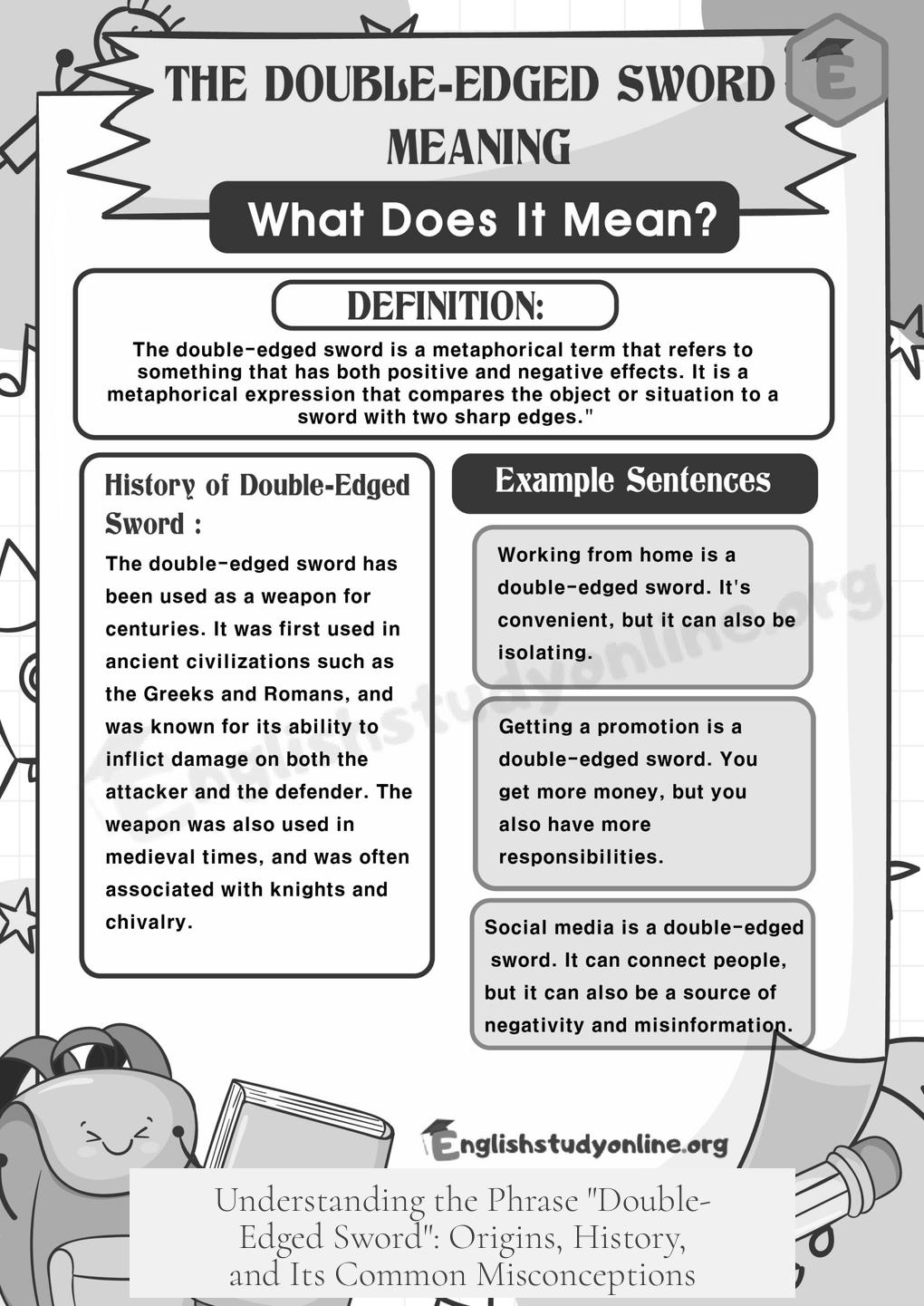We say “a double-edged sword” because historically most swords had two sharpened edges, which made the phrase a powerful metaphor illustrating something with both positive and negative effects. This expression originated in English in the early modern period, borrowing a concept that existed earlier in Arabic. While many swords were indeed sharpened on both sides, single-edged swords were also common, depending on the era and cultural context.
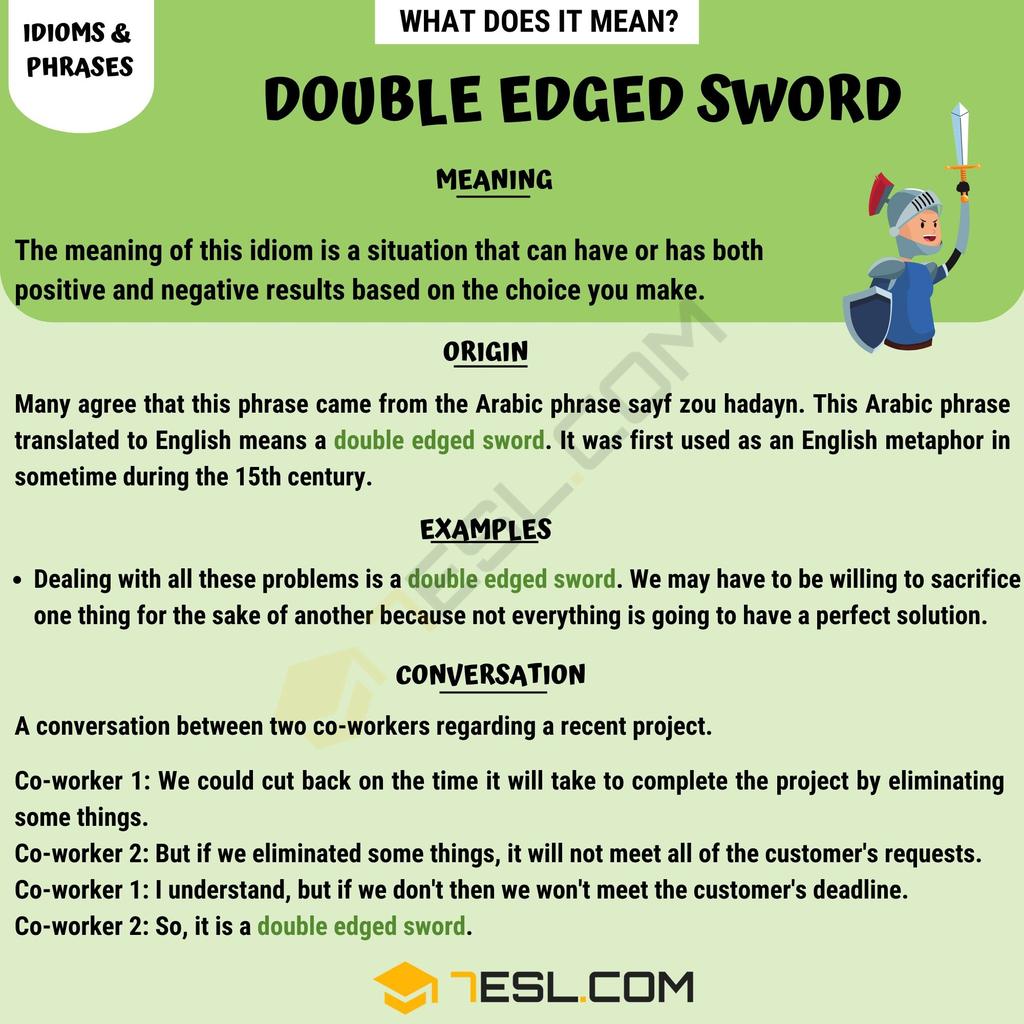
The metaphor “double-edged sword” highlights the idea of something capable of cutting in two directions. It conveys that a particular action or decision can have two outcomes: beneficial and harmful simultaneously. Originally, the metaphor linked very closely with the physical characteristic of double-edged blades that could cut both forward and backward. As English evolved, the phrase separated from its literal image, but it remains immediately understandable because of cultural familiarity with swords and the idiom “cut both ways.”
The earliest English usage of “double-edged sword” as a metaphor appeared in periods when people were more acquainted with swordplay. This metaphor was previously present in Arabic literature, which had a longer history of using sword imagery with precision due to their advanced blade-making traditions. However, no direct etymological line links the Arabic term to English usage. The metaphor became common in English after the medieval period when swords, especially in Europe, were often double-edged, making the idea concrete and relatable.
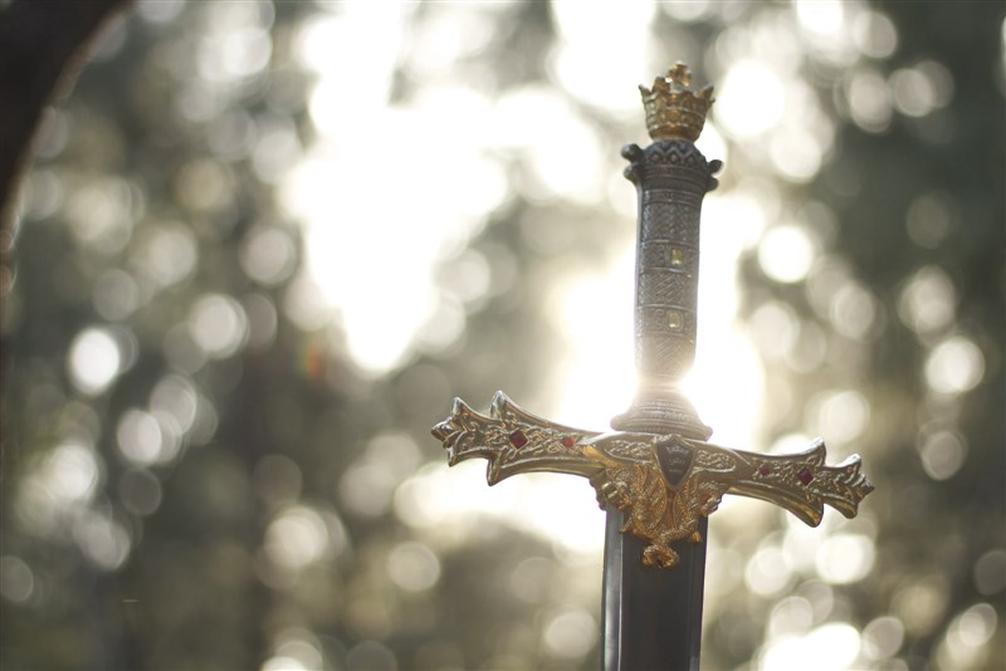
In fact, most ancient European swords, including the Roman gladius, were double-edged. These swords featured symmetrical blades sharpened on both edges and pointed tips for stabbing. The double edges allowed warriors to cut and parry from either side, an advantage in close combat.
- Roman gladius: short, double-edged, stabbing and cutting
- Medieval swords: still symmetrical with two sharp edges
During the Middle Ages, while sword construction became more complex, the double-edged design persisted. Swords now often had significant points and basic handguards, emphasizing thrusting. The two sharpened edges remained typical, though one edge might have been favored as the “front” to strike from. This front edge did not exclude using the opposite edge but was prioritized.
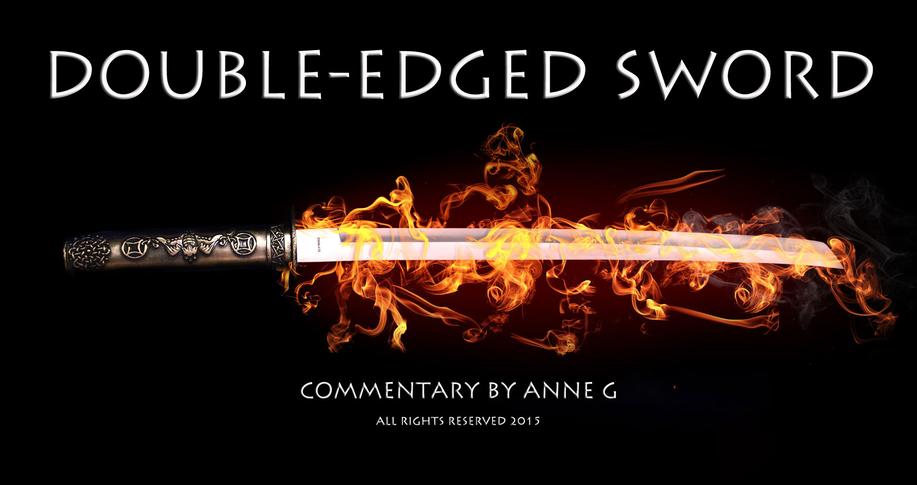
As European sword technology evolved in the late medieval and early modern periods, swords developed more specialized features. Guards grew intricate, and swords began to have a clearly designated front edge, usually sharpened for cutting effectiveness. A decline in heavy armor during this period encouraged the use of cutting strokes, elevating the importance of the sharpened front edge.
The early modern era saw even more specialization. Swords like the rapier often had one or two edges sharpened. Some rapiers had both edges sharpened at least partway down the blade, while others emphasized thrusting with sharpened points and minimal edge sharpening. Sabres, used by cavalry, were mainly curved for cutting and typically had one fully sharpened edge and a partially sharpened or blunt back edge to aid versatile use, including stabbing.

This specialization introduced single-edged swords into mainstream use alongside older double-edged designs. The curved sabre favored cutting strokes with a single leading edge sharpened, while the back edge might be sharp only near the tip or unsharpened.
| Era | Sword Type | Edge Type |
|---|---|---|
| Ancient Europe | Roman Gladius | Double-edged, sharp point |
| Middle Ages | Medieval longsword | Typically double-edged, front favored |
| Early Modern | Rapier | One or two edges sharpened |
| Early Modern | Sabre | One fully sharpened edge, partial back edge |
| Late Modern | Cavalry swords | Often single-edged or spike-like |
By the modern era, the evolution of firearms and bayonets reduced sword prominence. Cavalry swords focused more on stabbing, sometimes becoming single-edged or mere spikes. Thus, single-edged swords became notable, but the cultural image of swords as double-edged persisted in metaphorical language.
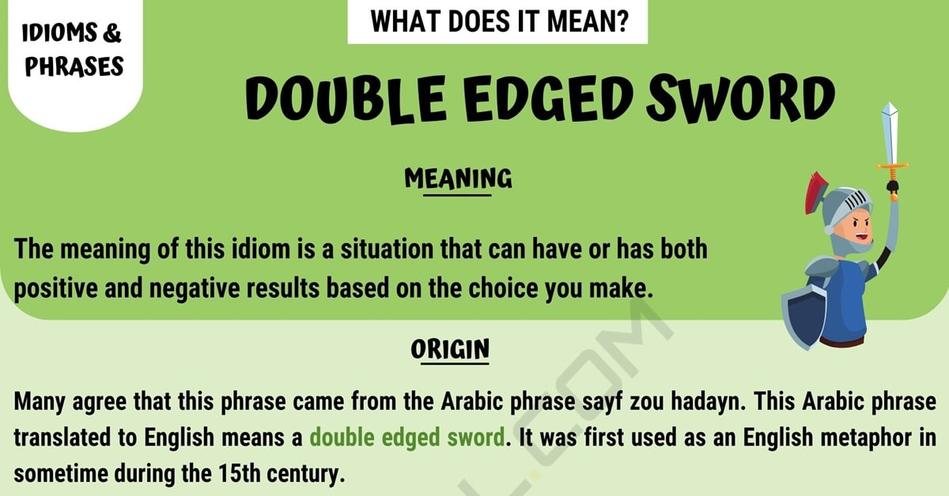
The metaphor’s endurance relates partly to this history. In the times when this phrase emerged, swords sometimes had two sharp edges and sometimes not. The image of a double-edged sword richly encapsulated the idea of a force capable of both helping and harming, applicable to concepts beyond weaponry. Hence, the phrase remains in use to describe dilemmas or tools that offer dual benefits and risks.
- “Double-edged sword” metaphor links directly to historical sword design.
- Originally described swords cut from both sides.
- Single-edged swords became common later with different blade types.
- Expression invoked complex advantages and dangers.
- Phrase persists due to cultural familiarity despite swords’ declining use.
Why Do We Say “A Double-Edged Sword” Like It’s an Exception? Exploring Its Origin and the Reality of Sword Edges
Why do we say “a double-edged sword” as if it’s some rare thing? Historically speaking, double-edged swords were quite common, especially in ancient Europe. The phrase rose as a metaphor to describe something with two consequences—both good and bad—that cut “both ways.” Let’s dive into the nitty-gritty of this expression, when it originated, and whether only one side of a sword was usually sharpened.
The phrase “a double-edged sword” smacks of drama, doesn’t it? Like it’s this unusual weapon wielded by a secret warrior. But in fact, **double-edged blades were the norm rather than the exception in many cultures.**
The Expression’s Origin: A Metaphor With a Cutting Edge
The metaphor “double-edged sword” pops up in English as a colorful way to say something has two effects—one benefit and one drawback. People use it to describe situations where both “edges” or consequences cut deeply.
- Interestingly, the phrase was already floating in Arabic long before it entered English.
- There’s no clear linguistic handoff from Arabic to English, though—they seem to have developed the idea separately.
- Early users paired the phrase with the idea of cutting “both ways.” For example, “His logic is like a double-edged sword, cutting both ways.” Today, these two parts are used independently, though originally they worked together.
Because swords aren’t part of everyday life now, the metaphor earns its keep by relying on collective cultural knowledge from history and literature. We *get* what it means without needing to sharpen the concept with more explanation.
Were Swords Usually Double-Edged? The Historical Slice
Now for the exciting truth: **most ancient European swords were double-edged.** Take the Roman Gladius—famous in history textbooks and epic films. This compact sword had two sharpened edges, perfect for stabbing and slashing alike.
This wasn’t an outlier. Many early medieval swords kept that design. A symmetrical, double-edged setup allowed fighters to cut and parry efficiently. Although one edge often became the “front” for most strikes, both edges remained sharp.
- In the Middle Ages, sword complexity increased, but the two-edged blade stayed customary.
- The point became vital to pierce armor, making the tip just as important as the edges.
However, as we approach the later medieval and early modern period, changes take shape. Swords gain more elaborate guards, which lock in your grip and often favor one edge for cutting.
When Single Edges Made Their Mark
In the Early Modern period, swords diverge into types based on cutting and thrusting needs:
- The rapier, famous for duels, sometimes had two edges but often varied, sometimes sharpening none or just one edge fully.
- Sabres came along with curved blades. Their leading edge was fully sharpened for slicing; the back edge was just a “helping edge,” sharpened lightly for occasional stabbing.
- These swords had strong guards because the hand needed better protection in fast-paced cutting actions.
This design reflects a **specialization in sword use**. While double edges remained usual in some forms, many swords chose a single sharp edge when that was a tactical advantage.
Modern Swords: More Variety, Less Two-Edged
As firearms replaced swords on the battlefield, sword designs diversified even more:
- Cavalry swords and cut-and-thrust weapons often sharpen only one edge.
- Some swords became mere pointed spikes for thrusting, abandoning edges almost completely.
So, over time, **single-edged swords became commonplace in certain military contexts.** But even then, double-edged swords never fully vanished. They remained in the arsenal for centuries.
Why Does the Metaphor Stick If Double Edges Aren’t Always the Default?
At the metaphor’s birth, people were familiar with swords, both double and single-edged. The metaphor’s strength came from its image of something that can “cut both ways,” which was useful to describe ideas or situations with dual effects.
Today, although the reality of sword design is mixed, the phrase keeps its punch. It’s seen as a handy way to talk about tricky scenarios without needing to spell out all the pros and cons.
Final Thoughts and a Little Swordplay Advice
So was it common to sharpen only one edge of a blade? Yes, depending on the era and purpose. But **historically, double-edged swords were far from rare**—they were quite standard. The metaphor “a double-edged sword” is not about rarity; it’s about dual impact. One edge might cut, but the other can slice back unexpectedly.
Next time you hear the phrase, picture a Roman soldier wielding a shiny Gladius, balanced on both edges, ready to cut through trouble from two directions. That image makes the metaphor clearer and more vivid.
Are there modern “double-edged swords” in your life? Maybe technology or decisions that help but also hurt? Now you know the historical roots of the phrase and can wield it wisely.
